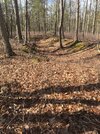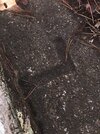Charcoal pit locations?
- Thread starter pinelandpaddler
- Start date
You are using an out of date browser. It may not display this or other websites correctly.
You should upgrade or use an alternative browser.
You should upgrade or use an alternative browser.
Nice finds Al.it was a ring of dirt about two ft high and 20 ft across with the depression in center actually being about ground level,a couple of the buttons were slightly depressed in center but some appeared to be rings on flat ground.When i dug in center there was about six inches of humus and then immediately black grimy decayed charcoal with lumps of intact charcoal in it.Now i would assume a charcoal site would have charcoal from oak/hickory which is what i think they used for charcoal for furnaces??? A tar pit would have pine charcoal.You would have to have it analyzed I imagine to tell the difference.Does anyone know what wood for sure as used to make charcoal for a furnace? There was a very old wagon road going through the area and several of the pits were right next to it.A very old road by the looks of it.An almost unused trail now. Oh and there was no clay.very fine sugar sand outside the pits,charcoal in them but I didn't go deep,maybe a foot.
I have Ted Gordon's essay about Herbert Payne, the last of the old time Charcoal Makers. Almost any wood can be used, and he did use pine too. At one point he was using railroad ties on the outside supplemented with pine.
Here is an interesting statement by Mr. Payne in the Gordon essay: "I've burned charcoal every conceivable way...from using that metal kiln you see sitting over there to that partially buried pit with the drainage pipes sticking out". The latter was his latest "coaling" experiment, suggested by descriptions of a true pit-method provided to him by soldiers who had observed it while serving in Vietnam.
Last edited:
Ted makes this caption on a photograph in the essay:
"A partially set charcoal kiln or "pit" (the latter, a misnomer) using eight-foot railroad ties. While earlier European charcoal production was done in pits below ground, the traditional American "pit" was always completely above ground. Almost any kind of wood could be burned into charcoal".
"A partially set charcoal kiln or "pit" (the latter, a misnomer) using eight-foot railroad ties. While earlier European charcoal production was done in pits below ground, the traditional American "pit" was always completely above ground. Almost any kind of wood could be burned into charcoal".
Tar kilns had clay bottoms that the liquified tar would flow down to before running through a pipe or trough into a bucket. What you visited might have just been a charcoal kiln ("Pit").it was a ring of dirt about two ft high and 20 ft across with the depression in center actually being about ground level,a couple of the buttons were slightly depressed in center but some appeared to be rings on flat ground.When i dug in center there was about six inches of humus and then immediately black grimy decayed charcoal with lumps of intact charcoal in it.Now i would assume a charcoal site would have charcoal from oak/hickory which is what i think they used for charcoal for furnaces??? A tar pit would have pine charcoal.You would have to have it analyzed I imagine to tell the difference.Does anyone know what wood for sure as used to make charcoal for a furnace? There was a very old wagon road going through the area and several of the pits were right next to it.A very old road by the looks of it.An almost unused trail now. Oh and there was no clay.very fine sugar sand outside the pits,charcoal in them but I didn't go deep,maybe a foot.
Gabe I hadn't realized why you asked me about clay bottoms but I just read something last night that states that tar kilns were lined with clay I presume so the tar doesn't sink into the sand or so the sand don't contaminate the tar.I did not dig down far enough to confirm weather there was clay or not and stopped as soon as i hit charcoal.When I investigate the pits on my next days off wed/thur I will take a full sized shovel(I was using an army etool) and will dig through the charcoal to see what I hit.There is no clay anywhere near these pits,they would have hauled it in up the old road I was following.Tar kilns had clay bottoms that the liquified tar would flow down to before running through a pipe or trough into a bucket. What you visited might have just been a charcoal kiln ("Pit").
Okay I have vids of four different pits,two didn't come out well so I"m not posting those.I also took a few pics I"ll throw in here as well.
Here is vid number one.
Here is vid number one.
First pic is a sandstone mine on top of a ridge,it was really pretty,nice open oak ridge
the others are of a Vineland Millville line stone,there are many of these and they all look fairly similar.The concrete base had an M on the south side for Millville and an L on the south side for landisvill twp.Untill 1952 Vineland was Vineland borough in the city center but most of Vineland was landisville twp.This stone was obviously place prior to 1952
the others are of a Vineland Millville line stone,there are many of these and they all look fairly similar.The concrete base had an M on the south side for Millville and an L on the south side for landisvill twp.Untill 1952 Vineland was Vineland borough in the city center but most of Vineland was landisville twp.This stone was obviously place prior to 1952
Attachments
New Jersey Roots - The Old Time Tar Kilns, Volume 3 Number 2
New Jersey History and Genealogy
Just found many of those grid like charcoal mounds east of Atsion.Looks like I"m going to be busy

A lot of little pimples just east of Aetna furnace as well,near the big cellar hole.i've been there and noticed the ground was kind of acnefied.
I have found a couple of areas down here like that in Peaslees and another area in Union Lake wma.
Up around Sleep Creek (of Mullica fame ) too. These things are way more abundant than I had realized. This new lidar is revolutionary.I have found a couple of areas down here like that in Peaslees and another area in Union Lake wma.





